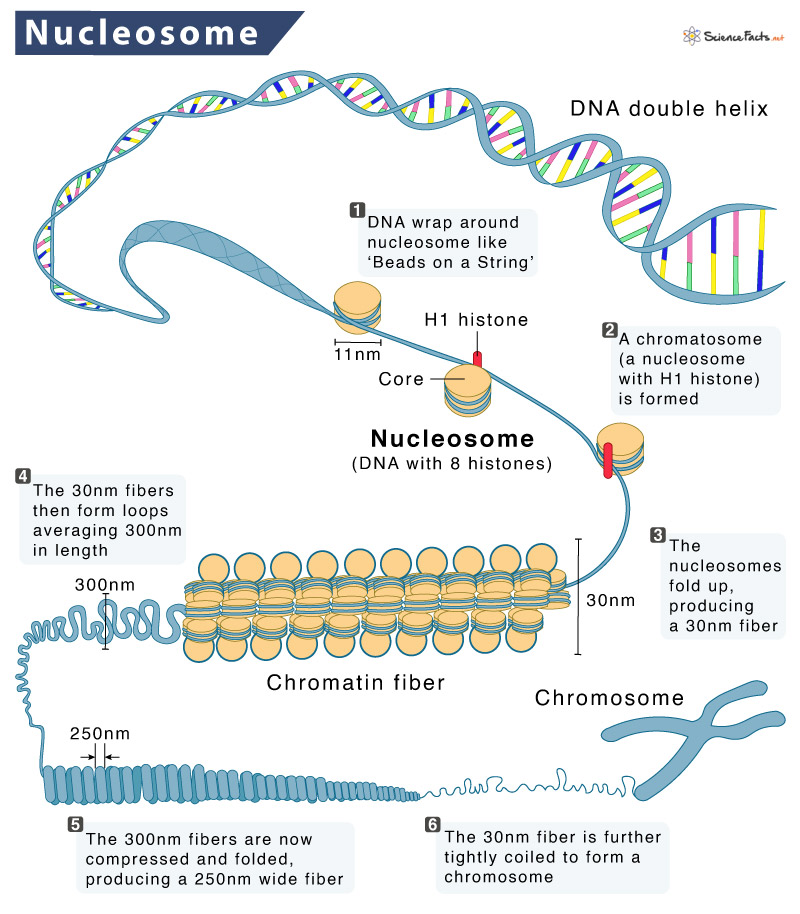Nucleosome
In higher organisms, to fit their genetic material (DNA) inside the cell’s nucleus, they must be packaged into a highly compact structure known as chromatin. Nucleosomes are the fundamental repeating subunit of chromatin which repeats every 160 to 240 base pairs (bps) across the eukaryotic genome.
The nucleosome is thus best described as the eukaryotic DNA associated with its histone proteins.
Nucleosome Structure
- The nucleosome core particle (11 nm wide) comprises almost 146 bps of DNA sequence tightly wrapped around proteins. The protein component consists of a set of eight proteins called histones, known as histone octamer.
- Each histone octamers is made of two copies of the histone proteins H2A, H2B, H3, and H4. However, in some cases, other histone variants may also be found in the core.
- The nucleosomes repeatedly fold to tighten and condense the packaged DNA, forming a chromosome. Thus, nucleosomes are structural building blocks of the DNA packaged within a chromosome.
A single nucleosome is not formed in isolation. Instead, part of a more extensive process whereby multiple nucleosomes associates with H1/H5 linker histones linearly along the DNA molecule. Each nucleosome has a diameter of approximately 11 nm. When viewed under a microscope, the structure resembles beads on a string.
Nucleosome Assembly: How is DNA Packaged in a Eukaryotic Cell
The DNA packaging process follows the following steps:
- The adjacent nucleosomes are linked by an additional histone protein (H1 histone) to form a string of chromatosomes (20-80 bps long). The negatively charged DNA is associated with positively charged amino acids on the surface of the histone proteins.
- The chromatosomes then coil up to form a solenoid structure (~6 chromatosomes per turn) condensed to form a 30 nm fiber.
- These fibers then form loops averaging 300 nm in length, which are compressed and folded around a protein scaffold to form a 250-wide chromatin fiber.
- Finally, chromatin supercoils during cell division, forming chromosomes (1400 nm in length) that are visible (when stained) under the microscope as ‘beads on a string’. The form in which cells carry genetic information in packages of DNA is called chromosomes.
Thus, DNA packaging in eukaryotes is achieved in three levels: First Level – Nucleosome, Second Level – Solenoid Fiber, Third Level – Chromatids, and Chromosome.
Nucleosome Functions
1. Ensuring Genome Compaction
As we know, the formation of the nucleosome is required for the compaction of the DNA to form chromatin. In other words, DNA packaging is essential to fit the DNA molecules into a chromosome. DNA compaction further helps nucleosomes to perform their other functions in the cell.
2. A Molecular Librarian
Nucleosomes are essential for protecting the delicate inner strands of DNA from any physical damage and thus are like a librarian to the cell.
3. Maintaining Cell Stability
They maintain the stability of the nucleus, keeping the DNA’s viability and associated proteins functioning correctly.
4. Allowing Access to DNA
Nucleosomes also act opposite to the function of a molecular librarian. They also must allow the information in DNA to be used by the polymerases to transcribe messenger RNA to form new proteins and replicate the DNA when the cell divides. Thus, nucleosomes act as the signaling hub inside the cell.
5. Modifying Gene Functions
Nucleosomes are also found to modify the activity of the genes they store. Each nucleosome consists of eight histone proteins tightly packed together at the center, encircled by two loops of DNA. The histone proteins have long tails which extend outward from the compact nucleosome, reaching out to neighboring nucleosomes and binding them tightly together. The regulatory enzymes in the nucleus modify these tails to weaken their interactions. In this way, the cell makes particular genes more accessible to polymerases, thus modifying their functions.
Nucleosome vs. Chromatin
As we know, chromatin and nucleosome are terms used together to describe the packaging of DNA inside the nucleus of a eukaryotic cell. We will now study the differences between the two:
Differences
| Basis | Nucleosome | Chromatin |
| 1. Basic Unit | It is the fundamental unit of chromatin in the nucleus | It is a complex of DNA and proteins that form chromosomes |
| 2. Appearance | 1) It appears as beads on a string 2) Less condensed than chromatin | 1) It appears as a thread-like looped structure 2) More condensed than nucleosomes |
| 3. Diameter | 11 nm | 30 nm |
| 4. Length of DNA | It consists of almost 150 bps of wrapped DNA | A loop consists of 40-100 kb of DNA |
Similarities
1. Found in eukaryotes
2. Made up of DNA wrapped around histone proteins.
3. Forms chromosomes
Nucleosome vs. Histone
From our previous sections, we know how histones are related to nucleosomes.
Similarities
- Components of chromatin
- Present within the nucleus of eukaryotic cells
- Associated with DNA packaging
- Confers genome stability
However, there are some differences.
Differences
Nucleosomes are the fundamental subunit of chromatin in the nucleus consisting of a segment of DNA wound around a core octamer of 8 histone proteins. In contrast, histones form the protein core of the nucleosome. There are five prominent families of such proteins (H1 to H5). H2A, H2B, H3, and H4 are the core histones. H1 and H5 histones are called linker histones.
-
References
Article was last reviewed on Friday, February 17, 2023




